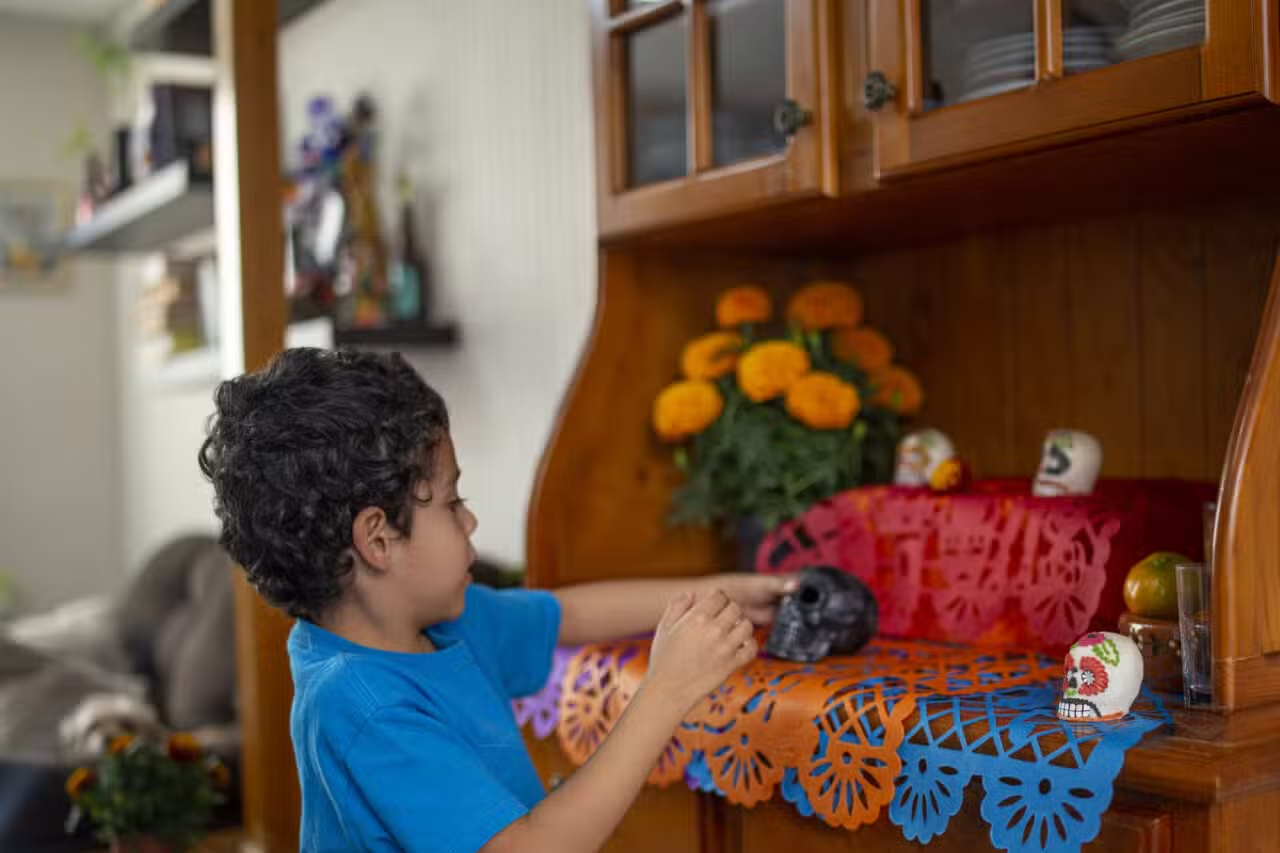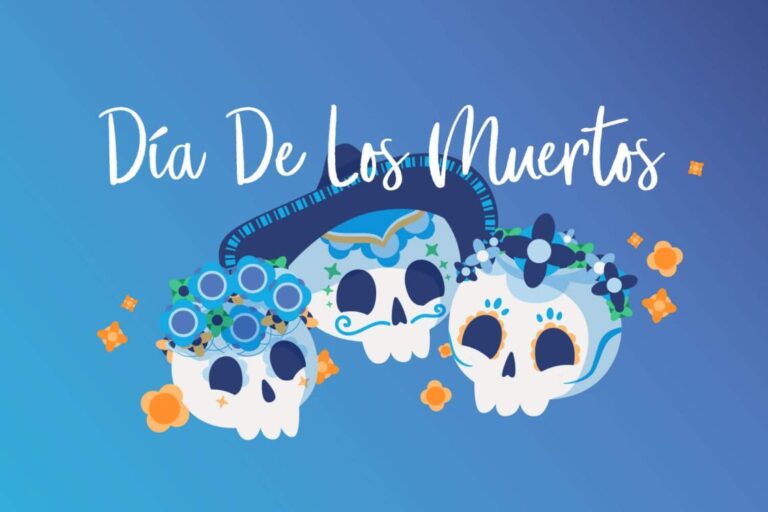Día de los Muertos, known as the Day of the Dead in English, is a traditional Mexican holiday. Day of the Dead celebrations last from October 31st to November 2nd. While many people across Latin America pay respects to their deceased loved ones during the first two days of November, Mexico is home to the best-known Día de los Muertos traditions.
This traditional Mexican holiday often starts the day after Halloween, mainly celebrated in the U.S. Thus, Mexican Americans often celebrate both in sequence. However, it’s not merely a “Mexican Halloween.” Continue reading this guide created by our team here at Remitly to learn more about this ancient tradition.

Table of Contents
A Brief History of Día de los Muertos
Día de los Muertos, or the Day of the Dead, began from the European Catholic traditions of All Saints’ Day and All Souls’ Day and from Aztec rituals that honored the deceased. Like many aspects of Mexican heritage and culture, it combines colonial traditions and the beliefs of the indigenous people who first lived in the country.
Day of the Dead celebrations originated in southern Mexico more than 3,000 years ago with the Mesoamericans who lived in what is now Mexico and Central America. When the Spanish invaded and forced conversion to Catholicism, those religious beliefs mingled with indigenous practices to form the basis of the modern holiday.
Día de los Muertos is foremost a day of joy, not mourning. At its heart, it acknowledges death as a natural part of the human experience. Traditional belief holds that during Dia de los Muertos festivities, the deceased can awaken from their eternal sleep in the spirit world and enjoy a brief reunion with their families. The idea of Día de los Muertos is to encourage visits from lost loved ones to share food, drink, and celebrations.
As previously mentioned, the modern Day of the Dead celebration also incorporates elements of two holidays from Catholicism. The first is All Saints Day, the date on the Catholic calendar when people pray for all the saints who have departed, and the second is All Souls Day, a time to say prayers for departed loved ones.

Day of the Death Traditions
Day of the Dead celebrations include a variety of traditions, some of which have become synonymous with Mexican culture outside of Mexico. Let’s take a look at some of the ways Mexicans celebrate this traditional day.
Day of the Dead Altars (ofrendas)
One of the most important elements of Día de los Muertos is a traditional altar, or ofrenda, to honor those who have gone before. The ofrenda also symbolically makes the deceased feel comfortable when visiting the living.
Families construct these altars inside homes, at grave sites in local cemeteries, and in public places and museums across Mexico and the U.S.
These public altars are often elaborate, detailed, colorful, and painstakingly crafted by families seeking to honor their deceased loved ones. Often, families gather to light candles after the makeshift altars are completed at their loved ones’ graves or in their homes.
When preparing an altar, some people include departed family members’ favorite foods and photos of them as they existed in life. These items have a specific purpose. They welcome returning family members after their long journey from the other side.
Ofrendas can also include:
- Copal, or traditional incense (dating to pre-Columbian religious ceremonies in Mexico)
- Cempazuchitl, or the marigold
- Religious imagery, such as a crucifix or an image of the Virgin of Guadalupe
- The four elements of nature — earth, wind, water, and fire — in various forms but often includes a clay cazuela or cooking pot (earth) and candles (fire)
- Personal effects, such as toys that belonged to deceased children or wedding rings from adults
When finished, ofrendas paint a picture of the deceased family members and what they enjoyed when they walked the Earth.
Above, you can see an example of an ofrenda one family made to honor deceased loved ones for Día de Muertos.
Notice that it includes images of the honored family members, along with flowers, incense, calaveras, pan de muerto, and some favorite foods and items of clothing of the deceased.
One final note regarding these altars: parents who have lost children may make altars and offerings on October 31st or November 1st as part of el Día de los Angelitos (the day of little angels). Keep in mind that, due to their nature, these altars carry additional significance and deserve respect and care.
Calaveras
Calaveras, or skulls, are among the most prominent symbols of Día de los Muertos. You’ll find them everywhere, from edible sugar skulls to papier mâché creations decorating homes and altars. Some calaveras have the names of deceased relatives scripted on their foreheads.
The significance of the skull and skeletal figure is to honor the continuous nature of life, laughing joyfully at death and accepting it as part of our everyday existence.
Among the most famous calaveras is la calavera catrina, often simply known as la catrina or “the elegant skull.” The famed “Lady of the Dead” image was created by a Mexican illustrator and lithographer named José Guadalupe Posada. Although it was originally meant to critique Mexicans wearing European fashions, it became popularized in the early 20th century as a symbol of the Day of the Dead.
Today, the illustration still features prominently in el Día de los Muertos celebrations everywhere, from Mexico City to other communities in remote areas.
Many artisans create skulls that are beautiful works of art meant to be enjoyed year-round. The carefully hand-painted ceramic skulls in the photo above were purchased at the Mercado Sonora pottery marketplace on the eastern outskirts of Mexico City. It has also found its way into modern pop culture outside of Mexico.
Pan de muerto
Pan de muerto (“bread of the dead” in English) is an important element of the home or graveside offering and is a well-loved part of the holiday. The round shape of the sweet bread represents the human body, the long shapes laid over the top of the bread represent the bones, and the round knot in the middle represents the skull.
Some accounts state that the bread dates back to pre-Hispanic times and may have taken the place of human sacrifices originally required by the Aztecs to honor the holiday. Old Aztec recipes may even have contained human blood, but thankfully, that is not the case in modern times.
Different chefs prepare this bread in different ways, and no two are exactly alike. Some breads rely on aniseed for their flavor, and others have orange zest and extract and zest. Modern savory breads can include sesame seeds, though sweet breads made with sugar remain popular.
Do you like baking? Pan de muerto is relatively easy to make at home.
Other Traditional Foods and Drinks
During Mexico’s Day of the Dead celebrations, there are other foods besides sweet bread that are commonly enjoyed, such as:
- Calabaza en tacha, a sweet dessert made from candied pumpkin
- Sugar skulls, highly decorative candies in skull shapes
- Mole negro, a savory dish made with chocolate and blackened chiles
- Tamales, masa, and other ingredients steamed inside a corn husk
- Sopa Azteca, a spicy tortilla soup
- Pepitorias, cakes made out of pumpkin seeds and sugar syrup
- Alegrias, cakes made out of amaranth, dried fruits, nuts, and honey
- Atole, an ancient drink made of corn flour, cinnamon, brown sugar, and chocolate or vanilla
- Pulque, an alcoholic beverage made from the sap of the maguey plant
You may also see some of the above foods placed at a Day of the Dead altar as a part of the Mexican tradition of leaving food for the dead.
Marigolds
Known as the flor de muerto, the Mexican marigold is prized for its vibrant color and distinctive fragrance. During Day of the Dead celebrations, many families place marigolds on their altars to attract the souls of the dead. Some people even scatter a trail of marigold petals from their door to lead their loved ones to the Day of the Dead altar inside.
The Day of the Dead Parade
In many cities and villages, people celebrate the Day of the Dead together as a community by holding a large parade. For the event, people dress in traditional Mexican dresses and other traditional clothing and take to the streets. Many people participate in face painting, decorating their faces with an elegant skull design.
During the parade, bands play music, and people dance, sing, and eat delicious food. These parades take place throughout Mexico and beyond. For example, a famous parade occurs every year along the Riverwalk in San Antonio, Texas.
Mass
As previously mentioned, the Day of the Dead is a multi-day holiday with the Mexican version of All Souls Day. The influence of Catholicism on the Day of the Dead festivities means that many people attend mass on November 1.
During the Día de Muertos mass, families say prayers to help the dead find peace and eternal life. It’s customary to light candles in the church before the service.
Día de los Muertos Celebrations Today
As widespread migration has separated many families from ancestral cemeteries and graves, Día de los Muertos celebrations have evolved. The holiday has gained widespread recognition in the U.S., in particular, through media attention and a growing Mexican population. Many cities in the United States hold large events and festivals celebrating and honoring Day of the Dead traditions.
There has been controversy in some communities over the commercialization of the holiday. That’s because, though not always meant to be solemn, Day of the Dead festivities are deeply personal and rooted in family history.
This beloved holiday is a resilient, unique celebration of life and death for communities in Mexico and among the Mexican diaspora.
FAQs
Día de los Muertos, or Day of the Dead, is a traditional Mexican holiday celebrated from October 31st to November 2nd. While many Latin American countries observe the holiday, Mexico is home to the most recognized traditions. This celebration honors deceased loved ones, encouraging them to return from the spirit world to reunite with their families and enjoy food, drink, and festivities.
Some of the most important traditions of Día de los Muertos include creating altars (ofrendas) to honor the deceased, decorating them with items like marigolds, candles, and food offerings such as pan de muerto (bread of the dead) and sugar skulls. Families often attend mass, light candles, and may participate in festive parades. The holiday combines indigenous Mesoamerican rituals and Catholic traditions, celebrating life while acknowledging death as a natural part of existence.
